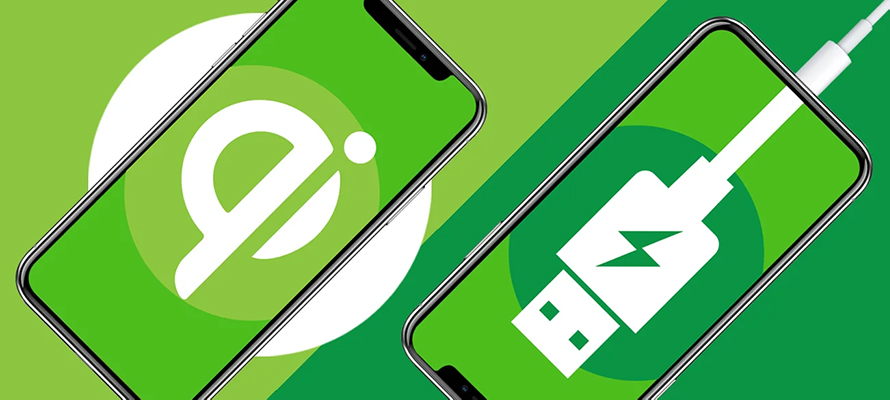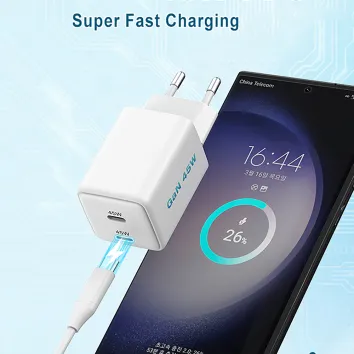Wireless Charging vs. Wired Charging: Which Is Better in 2025?
🔋 Introduction
Wireless charging is no longer a futuristic concept — it’s part of everyday life. But when compared with wired charging, especially with today’s GaN fast chargers, PD chargers, and PPS-enabled adapters, does it really hold up?
In this article, we’ll compare wireless vs. wired charging from efficiency, safety, compatibility, and user experience. We’ll also give insights for brands, OEM charger suppliers, and wholesale buyers to help decide where to focus in 2025 and beyond.

1. What Is Wireless Charging & How It Works
Wireless charging typically follows the Qi standard, using magnetic induction or resonance to transfer energy.
·Power levels range from 5W to 15W, with some advanced models supporting 30W wireless charging.
·The main appeal is convenience: no plugging in, no cable wear.
·Downsides: lower efficiency (60–75%), noticeable heat, and sensitivity to alignment.
👉 Related: What Is PD Fast Charging?
2. Why Wired Charging Still Leads
With 65W, 100W, and even 240W chargers available, wired charging remains essential for laptops, tablets, and high-performance smartphones.
3. Fast Charging Protocols: PD, PPS, and GaN
·PD (Power Delivery): The global wired fast charging standard, supporting multi-voltage levels (5V/9V/15V/20V/28V).
·PPS (Programmable Power Supply): An extension of PD, adjusting voltage/current dynamically — widely used in Samsung fast charging.
·GaN (Gallium Nitride): A semiconductor breakthrough enabling smaller, cooler, and more powerful chargers (20W–240W).
Wireless charging is evolving, but wired GaN PD/PPS/AVS chargers deliver unmatched efficiency.
👉 Related: Quick Charge 3.0 vs. 4.0
4. Real-World Performance Testing
Example results from multiple devices:
·30W wired PD charger: 0–80% in ~30 minutes.
·15W wireless charger: 0–80% in ~90 minutes.
·Heat levels: Wired GaN chargers average 35–40°C; wireless chargers can reach 45–50°C.
For users who need fast top-ups, wired charging is the clear winner. Wireless charging is best for overnight charging or casual desk use.
5. Pros & Cons
Wireless Charging – Pros
·Convenient, no plug-in required
·Reduces port wear
·Modern user experience (especially on desks and cars)
Wireless Charging – Cons
·Lower efficiency
·Limited power output (15W–30W)
·Generates more heat
Wired Charging – Pros
·High efficiency, supports 45W / 65W / 100W / 140W / 240W charging
·Compatible with PD, PPS, AVS, and QC protocols
·Better thermal control
Wired Charging – Cons
·Requires cables and ports
·Cable wear over time
6. Advice for Brands & OEM Charger Factories
·Charger Manufacturers (OEM/ODM): Focus on multi-protocol GaN chargers (PD + PPS + Qi wireless) to cover both wired and wireless needs.
·B2B Buyers & Wholesalers: Offer wired chargers (65W–140W) for performance devices, plus wireless pads for lifestyle markets.
·Future Outlook: Wireless charging will grow in convenience applications, but wired charging remains dominant in power-intensive devices.
👉 Related: Charger Manufacturing Process
❓ FAQ: Wireless vs Wired Charging
Q1: Is wireless charging bad for battery health?
Not necessarily, but higher heat during wireless charging can slightly reduce long-term battery lifespan compared to efficient wired charging.
Q2: Can wireless chargers support laptops?
No, current wireless technology is limited to low-power devices. Laptops still require 65W–140W PD chargers.
Q3: Should I buy a 30W wireless charger?
Yes, if you prioritize convenience. But for fast charging speed, a 65W USB-C PD charger is still faster.
Q4: Will smartphones go fully wireless in the future?
Possibly, but not soon. High-performance devices like gaming phones and laptops still need high-wattage wired charging.
🔚 Conclusion
Wireless charging is here to stay, but wired charging remains the gold standard for efficiency, speed, and compatibility.
For now, the smart approach is hybrid: use wireless chargers for convenience, and rely on GaN PD fast chargers (65W–240W) for serious power needs.

Read More
Wireless charging typically follows the Qi standard, using magnetic induction or resonance to transfer energy.
·Power levels range from 5W to 15W, with some advanced models supporting 30W wireless charging.
·The main appeal is convenience: no plugging in, no cable wear.
·Downsides: lower efficiency (60–75%), noticeable heat, and sensitivity to alignment.
👉 Related: What Is PD Fast Charging?
2. Why Wired Charging Still Leads
| Feature | Wired Charging | Wireless Charging |
| Efficiency | 90% + with PD/GaN | 60-70% |
| Power Support | Up to 240W(GaN PD 3.1) | Typically 15W - 30W |
| Heat Management | Stable | Higher heat, more loss |
| Conpatibility | PD, PPS, QC, AVS, USB-C | Qi only |
| Cost | Lower | Higher |
3. Fast Charging Protocols: PD, PPS, and GaN
·PD (Power Delivery): The global wired fast charging standard, supporting multi-voltage levels (5V/9V/15V/20V/28V).
·PPS (Programmable Power Supply): An extension of PD, adjusting voltage/current dynamically — widely used in Samsung fast charging.
·GaN (Gallium Nitride): A semiconductor breakthrough enabling smaller, cooler, and more powerful chargers (20W–240W).
Wireless charging is evolving, but wired GaN PD/PPS/AVS chargers deliver unmatched efficiency.
👉 Related: Quick Charge 3.0 vs. 4.0
4. Real-World Performance Testing
Example results from multiple devices:
·30W wired PD charger: 0–80% in ~30 minutes.
·15W wireless charger: 0–80% in ~90 minutes.
·Heat levels: Wired GaN chargers average 35–40°C; wireless chargers can reach 45–50°C.
For users who need fast top-ups, wired charging is the clear winner. Wireless charging is best for overnight charging or casual desk use.
5. Pros & Cons
Wireless Charging – Pros
·Convenient, no plug-in required
·Reduces port wear
·Modern user experience (especially on desks and cars)
Wireless Charging – Cons
·Lower efficiency
·Limited power output (15W–30W)
·Generates more heat
Wired Charging – Pros
·High efficiency, supports 45W / 65W / 100W / 140W / 240W charging
·Compatible with PD, PPS, AVS, and QC protocols
·Better thermal control
Wired Charging – Cons
·Requires cables and ports
·Cable wear over time
6. Advice for Brands & OEM Charger Factories
·Charger Manufacturers (OEM/ODM): Focus on multi-protocol GaN chargers (PD + PPS + Qi wireless) to cover both wired and wireless needs.
·B2B Buyers & Wholesalers: Offer wired chargers (65W–140W) for performance devices, plus wireless pads for lifestyle markets.
·Future Outlook: Wireless charging will grow in convenience applications, but wired charging remains dominant in power-intensive devices.
👉 Related: Charger Manufacturing Process
❓ FAQ: Wireless vs Wired Charging
Q1: Is wireless charging bad for battery health?
Not necessarily, but higher heat during wireless charging can slightly reduce long-term battery lifespan compared to efficient wired charging.
Q2: Can wireless chargers support laptops?
No, current wireless technology is limited to low-power devices. Laptops still require 65W–140W PD chargers.
Q3: Should I buy a 30W wireless charger?
Yes, if you prioritize convenience. But for fast charging speed, a 65W USB-C PD charger is still faster.
Q4: Will smartphones go fully wireless in the future?
Possibly, but not soon. High-performance devices like gaming phones and laptops still need high-wattage wired charging.
🔚 Conclusion
Wireless charging is here to stay, but wired charging remains the gold standard for efficiency, speed, and compatibility.
For now, the smart approach is hybrid: use wireless chargers for convenience, and rely on GaN PD fast chargers (65W–240W) for serious power needs.

Read More
{$Porduct}
{$Porduct}